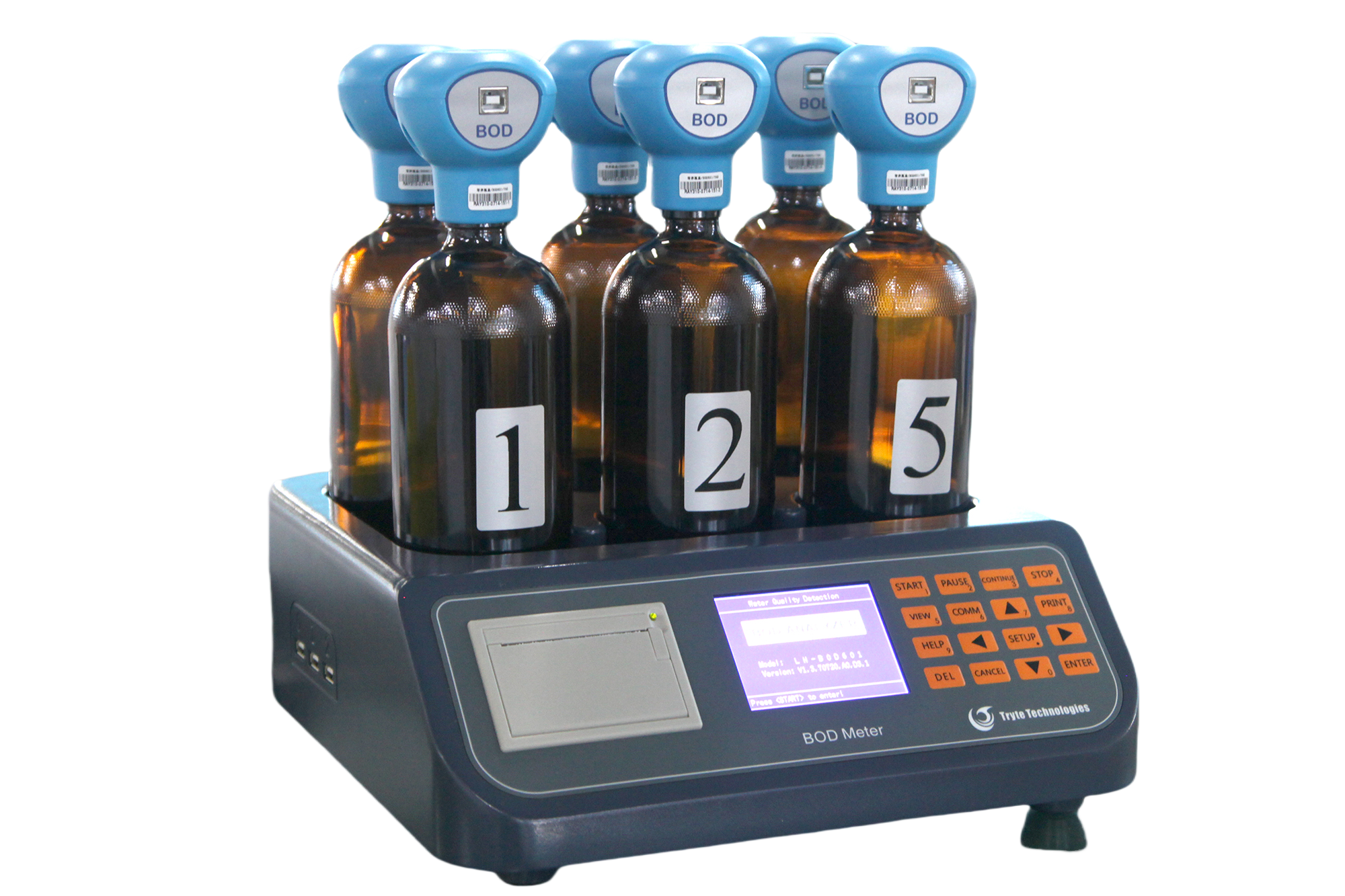Kif Tagħżel l-Analizzatur BOD Iż-Żgħir għall-Laboratorju Tieghu?
Fhemx it-Talba Bioċimiċa għall-Oksiġenu u l-Ruolu tal-Analizzaturi BOD

Malik huwa Demanda Bioċemika tal-Ossigeno (BOD)?
Id-domanda bioċimiċa għall-oksiġenu, magħrufa komunement bħala BOD, tibbassar ossigen li mikrobi jkollhom bżonn biex jaqsamu l-ogħġa organika li tiġib fl-ilma meta jkun hemm oksigenu bis-suffiċjenza disponibbli. Din il-miżura taħdem bħala waħda mill-indikaturi ewlenin li l-ilma possibilment inqasam, fejn in-numri iktar kbir ifisser li hemm iktar skart organiku preżenti. Il-biċċa l-kbira tan-nies toqgħod mal-liġi standard ta' ħames ijiem jew BOD5 għal qorti. Din il-metodu tara kemm oksigenu jitneħħi matul dawk il-ħames ijiem fit-temperatura tal-kamra madwar 20 darba Celsius, li sar tipu ta 'standard tal-ħobż għall-verifika jekk ir-regolamenti ikunu qed jiġu rispettati. Illum-a-jum madankollu, tekniki ġodda jimxu 'l barra minn dak il-marka ta' ħames ijiem biex ikollhom veduta sħiħa tal-konsum totali tal-oksigenu li jseħħ, anke matul id-darbiet diffiċili tan-nitifikazzjoni. Dawn l-improvements jagħtulu l-plants il-kapaċità li jsegwu kontinwament il-proċessi tagħhom u jagħmlu regolazzjonijiet kif meħtieġ mingħajr ma jistennu ġimgħat għall-riżultati.
Importanza tal-Miżura Eżatta tal-BOD fil-Valetta tal-Kwalità tal-Ilm
Importanti li jkunu miżuri preċiżi tal-BOD meta jiġi verifikat jekk il-ilma tal-kanal effettivament ikkompli jissodisfa d-dispożizzjonijiet ambjentali qabel ma jitlaq fl-ilma. Jekk il-qrajkiet ma jkunux korretti, allura aħna nikklu b’iskart parzjalment trattat li jitlaq barra, li jwassal għall-ebda ta’ livelli tal-oksiġenu fir-rodiet u l-baħar. Skont riċerka mill-EPA fl-2022, meta pjanijiet tat-trattament ikollhom żballi fil-miżura li jaqsmu 10%, ikollhom madwar 34% iktar każijiet fejn l-ilma li jmiss isir perikolużament baxx fl-oksiġenu. Barra minn sempliċement jissodisfa r-regolamenti, id-data tajba tal-BOD tgħin lippjanifikaturi tal-belt jagħmlu għażliet intelliġenti dwar l-infrastruttura tagħhom. Ħsieb fuq dan mod: ma’ x’qed isir mal-livelli tal-BOD jagħti l-bliet il-għarfien kif iddeterminaw fejn jispejndu fl-improvements minflok jikbru bil-multas li jistgħu jaqsmu $120k kull sena jekk jiflu fit-testijiet.
Funzjonalità Ewlenija tal-Analizzaturi Moderni tal-BOD
Analizzaturi tal-BOD ta’ llum jgħorbu metodi ottiċi, sensuri elettrokimiċi, u teknoloġija manometrika kollha mirata biex tikseb risultati aħjar iktar malajr. X’jagħmel dawn id-dispożittivi distinti? Għandhom kontrolli interni tat-temperatura li jibqgħu fi ħdan il-medda ±0.2°C, jsegwu kostantement livelli tal-oksiġenu dissolvet permezz ta’ sonżijiet luminesċenti jew polaroġrafiċi, u jiġu mgħammra b’karatteristiċi smart ta’ kalibrazzjoni bbażati fuq standard NIST. Skont riċerka ppubblikata fil-Ġurnal Water Research fl-2023, l-operaturi juru madwar 62% iktar ftit żbalji meta jużaw dawn is-sistemi awtomatiċi kontra t-tekniki manwali antiki tat-titrazzjoni. Plush, jagħtulu qari bejn 24 sa 48 siegħa li jitlob il-waqt ta’ spiss ta’ ħames ijiem għall-metodi tradizzjonali ta’ inkubazzjoni b’tul kbir. Il-verżjonijiet iktar avvanzati saħansitra jkombinaw miżuri tal-BOD ma ‘mudelli ta’ data nutrizjonali, jgħinu lil mmaniġers tal-plants jaġġustaw dożi kimiċi aktar preċiżament u fil-finalità jibdew il-proċessi tat-trattament iktar effettivament.
Kompjarazzjoni ta' Metodi ta' Kejl tal-BOD: Preċiżjoni, Velocità u Affidabilità
Metodu Standard ta' Inkubazzjoni kontra Teknoloġiji Ħodejn għall-Istqar tal-BOD
Għalissa, il-metodu ta’ inkubazzjoni ta’ ħames ijiem għall-BOD għadu jitqies l-approċċ ewlieni regolatorju, li jipprovdi preċiżjoni ta’ madwar plus vel minus 5 fil-cent meta jiġi kejl l-oksiġenu dissolvet skont il-linejamenti tal-EPA mill-belt-il sena. Iżda hemm opzjonijiet iktar malajr disponibbli nhar il-lum ukoll. Xejnejt bħal teknoloġija ta’ ċelluli tal-karburant mikrobiku u dawk is-sensores ottiċi jistgħu jagħtuk risultati fi żmien ftit sigħat biss, u fil-fatt ikkompara b’mod tajjeb mal-metodi klassiċi madwar 90 sa 95 fil-cent tal-ħin. Meta najru studji varji ppubblikati fl-2023 li jikkonfrontaw approċċi differenti ta’ rikonoxximent, naraw xi ħaġa li kollha nafu iżda qatt ma nitkellmu fuqha bil-mod iffukat – il-kompromiss bejn kif malajr xejn jaħdem u kif preċiżu irid ikun għal ċerti applikazzjonijiet, pluss jekk in-nies ser jaċċettaw komuni bihom fis-situżjonijiet reali.
| Metodu | Veloxità | Prezzizzjoni | Aċċettazzjoni Regolatorja |
|---|---|---|---|
| inkubazzjoni ta' Ħames Ijiem | 120 siegha | ±2% | Globali |
| Ċellula tal-Karburant Mikrobiku | 4 oraj | ±8% | Ġurisdizzjonijiet limitati |
| Sensur Ottiku | 70 minuta | ±5% | Programmi pilota |
Filwaqt li l-metodi rapidi jħaffu t-teħid tad-deċiżjonijiet, l-adozzjoni regolatorja limitata tagħhom tenfasizza l-ħtieġa ta' validazzjoni kontinwa.
Il-prestazzjoni u l-preċiżjoni tas-sensuri ottiċi, manometriċi u elettrokimiċi
Tliet tipi primarji ta' sensuri jħaddmu analizzaturi moderni tal-BOD:
- Mediżori Optiku jidentifika l-ittemprar bil-fluworexxenza b'riżoluzzjoni ta' inqas minn 0,1 mg/L
- Sistemi Manometriċi kejl tal-bidliet fil-pressjoni b'riproduċibbiltà ta' ±1%
- Magni tal-magni tal-magni isegwi l-konsum tal-ossiġnu permezz ta' varjazzjonijiet tal-kurrent tal-membrana
Evaluazzjonijiet oħra juri li s-sistemi manometriċi jilħqu konżistenza tad-data ta' 98% fuq partijiet kbiri ta' kampjuni, li jagħmlu ideali għal laboratorji b’kapacità għolja. Is-sensuri elettrokimiċi ikkw performa aħjar f’mediji b’BOD baxx (0–40 mg/L), komuni fit-25-il darba inizjali tat-trattament tal-ilma sporcu.
Valutazzjoni tal-Karigi: Metodi Rappidi kontra Metodi Standard f’Kuntesti Regolatorji
Fil-kariga, biss 12 fil-cent tal-agħenziji ambjentali jaqblu komuniement biex jużaw ir-riżultati tat-test veloċi tal-BOD meta japplikaw il-permessi, anke jekk r-riċerka sseħħet li dan ikkompara mal-metodu tradizzjonali ta' 5 ijiem madwar 87 fil-cent tal-ħin skont l-istandards ISO 5815. Hemm diversi raġunijiet għaliex dan għadu ma ġieb xejn sal-lum. Abbażi, is-sensuri tendu jinżlu b’mod gradwali, diża minn madwar 3 fil-cent kull ġimgħa li jista’ jwassal għal qari mhux korrett. Barra minn hekk hemm problema kbira ta’ interferenza meta jiġi xejn kif il-kampjuni li fihom ħafna materjal solidu. Il-noti tajba hija li l-ekwipaggji ġodda li qed jinħarġu jissemplifikaw ħafna dawn il-problemi permezz ta’ korrezzjonijiet intelligenti tal-kollox ibbażati fuq intelliġenza artifiċjali u sistemi aħjar ta’ kalibrazzjoni li jirregolaw il-lorvelwot awtomatikament. Dawn l-improvements jagħmlu t-teknoloġija ħafna iktar affidabbli għall-użu regolatorju attwali f’ambjenti differenti.
Speċifiki Tekniċi Importanti li Jridu Jingħataw Estensjoni fl-Analizzaturi tal-BOD
Kontroll u Stabilità tat-Temperatura għal Qarit BOD Konżistenti
It-temperatura għandha effett kbir fuq kif il-mikrobi jikkundukw, ikkomplikaw ir-reattività tagħhom b’madwar plus jew minus 12% kull grad Celsius skont riċerka reċenti tal-EPA mill-2023. L-istħarrijiet moderni illum iżżewwu jagħmlu xejn stabili, iżżewwu jitżilu t-temperaturi f’medja ta’ nofs grad fis-safra ottimali ta’ 20 sa 25 darba Celsius permezz ta’ sistemi ta’ kontroll termiku tad-doppju ċikel. Ikollu dan il-kontroll strett jagħmel idifferenza kollha meta l-laboratorji jippreparaw risultati konżistenti. Fl-imtieġ, id-differenzi bejn laboratorji spiss kienu jinġabarzu għal varjazzjonijiet sempliċi fit-temperatura fl-ambjent tagħhom, xi ħaġa li fil-fatt spjegħat madwar 3 minn kull 10 diskrepanzi fl-kejl tal-BOD dak iż-żmien.
Kapaċità tal-Kwantità u tal-Volum tat-Kampjun għall-Effiċjenza tal-Laboratorju
Għallaboratorji li jipproċessaw aktar minn 200 kampjuni kull xahar, il-kapaċità tat-trasferiment hija kritika. Analizzaturi b’effiċjenza għolja jappoġġjaw mill-inqas 60 test simultanji u jwettqu ċikli f'8 minuti. Il-karga awtomatika tonqos il-ħin tal-interazzjoni manwali b’73%, skont il-benċmarkijiet tal-laboratorji tat-tfulija. Il-metriki komparattivi iwasslu l-vantaġġi fl-iskalabbiltà:
| Karatteristika | Model Standard | Model ta’ Kapaċità Għolja |
|---|---|---|
| Test Simultanji | 30 | 60 |
| Trasferiment Ta’ Kuljum | 90 | 180 |
| Punzjoni tal-Korrettivu fuq Skala | 6.2% | 2.8% |
Preċiżjoni, Konżistenza tad-Data, u Indikazzjonijiet minn Studji tal-EPA
Skont ir-rapport tal-2021 EPA Precision Initiative, analizzaturi BOD imdumijja sewwa jistgħu jilħqu konżistenza ta’ madwar 98% meta jkejlu kampjuni ta’ referenza ta’ 300 mg/L fuq 100 test. L-unitajiet li jwettqu l-aqwa normalment juri koefiċjent ta’ varjazzjoni iktar baxx minn 2%, li jiġi kkunfermat permezz ta’ ħafna karigi tat-test, sensuri ta’ ossiġenu dissolvet tracciabbli mal-NIST, u sistemi li korriggw awtomatikament il-problemi ta’ drift. Meta nikkunsidraw id-data minn 47 faċilità municipli differenti għal 12-il xahar, il-baħħthija wasslu għal konklużjoni li jagħmlu kalibrazzjonijiet kull sitx-il xahar inaqsu l-varjabbiltà tal-kejl b’madwar 40%. Dan juri ċar kif il-manteniment regolari huwa importanti ħafna biex ikunu disponibbli risultati affidabbli kuljum.
Żgħal Il-Konformità Regolatorja u Standards ta’ Ċertifikazzjoni
Ċertifikati Essenzjali: ISO 9001, Konformità ma’ EPA, u Rekwiżiti tal-Industrija
Ikċertifikazzjoni korretta għandha importanza kbira meta jirrigwarda l-ewwżjar kif il-lanalisaturi jaħdmu u n-nut li jibqgħu fi ħdan ir-regolamenti. Il-kertifikazzjoni ISO 9001 turi b’mod bażiku li l-manifattur jsegwi prattiki tajba ta' kontroll tal-kwalità tul il-produzzjoni. Imbagħad hemm l-EPA Method 40 CFR Part 136 li jitħaddem biex iċċekkja jekk l-iktar apparati jagħtux risultati preċiżi speċifikament għall-ipprova ta' kampjuni ta' ilma tal-kanal. Studju riċent tas-Sena 2023 wassal għall-konklużjoni li l-makkinarji mfabbriki skont il-gwida EPA wrew f'dawk li jikkorispondu mad-differenza bejn laboratorji differenti madwar il-23% iktar aħjar. L-faċilitajiet industrijali jeħtieġu dawn iż-żewġ kertifikati mhux biss minħabba li jixtiequ jsegwu r-rekwiżiti tal-Akkta tal-Ilsien Nett imma wkoll minħabba li possess tagħhom jsemplifika l-isforzi tagħhom matul l-awdits. Ippjanijiet li ma jkollhomx dawn il-marki spiss isejħu jispendu aktar ħin biex jispjegwahom lil ir-regolaturi.
Rwol tal-Verifika tat-Tielet Parti fl-Ibni Trasta fil-Resultati BOD
Meta tifatturu jagħmlu dawk il-klajms dwar il-prodotti tagħhom, il-konvalidazzjoni ta' parti terza taħdem bħala verifika indipendenti tal-li jgħidu. Esperti jaħdmu fuq xejn bħal kemm is-sensuri jitwettqu wara ħin, li għall-iżvalt apparati huwa madwar plus jew minus 0.2 mg/L wara 30 jum, kif ukoll jekk bidliet fit-temperatura jaffettwaw ir-qari korrettament. Il-laboratorji li jikbru dan it-tip ta’ test estern ikunu iktar meqruda mill-autoritajiet, speċjalment fejn ir-regolamenti huma strikti. Skont riċerka ppubblikata l-aħħar sena, if-faċilitajiet li kien hemm il-pajpjar tagħhom ivvalidata sewwa wasslu għal drapita fil-konflitti regolatorji b’pratifikament ta’ erba’ minn ħames, madwar 41%. Ikbar dan it-tip ta’ reviżjoni esterna jagħmel differenza kbira meta jviene l-ammanna tat-tqieled tal-BOD li jintuża fir-reports u f’determinazzjonijiet uffiċjali dwar il-gestjoni tal-kwalità tal-ilma f’mediji differenti.
Valutazzjoni tal-Kost Totali tal-Posess u Appoġġ mill-Manifattur
Barra mir-Prezz tal-Akquist: Mantennanza, Kalibrazzjoni, u Kostijiet tal-Iżbal
Il-prezz inizjali huwa biss l-bidu meta jħallu investiment fl-iktar apparati tal-laboratorju. Ħafna mmaniġers tal-laboratorju spiss jinneklu dawk il-kostijiet kontinwi li jżidu darbien wara darba. Ara x'jiżda wara l-akkwist: is-sistemi ottiċi kbir jeħtieġu manutenzjoni annwali ta’ madwar $2,800, filwaqt li r-rikalibrazzjoni waħda tista’ tikkupja minn 15 sa 30 sigħa kull sena. U jekk il-mudelli elettrokimiċi jimxu mingħajr servizz adekwat, l-akkurata tagħhom tendi tibda tisfar minn 5% sa 7% iktar ħażina minn dawk immanutenuti. Dati industrijali reċenti tas-Sena 2023 iwasslu fuq xi ħaġa interessanti wkoll. Il-laboratorji li ppjanjaw bil-qabel b’soluzzjonijiet totali għall-kosta tal-posess ikkonsegwu li jnaqsu l-kejl globali tagħhom b’madwar 31% tul il-ħajja tal-apparat, minflok stennija sakemm il-komponent jinharabi qabel ma jiġi riparazzjoni.
Paragun tal-Kosta tal-Ċiklu tal-Ħajja ta’ Mudelli Kbar tal-Analizzatur BOD
| Fattur tal-Ispejż | Sistemi Manometriċi | Mediżori Optiku | Unitajiet Elettrokimiċi |
|---|---|---|---|
| kostijiet tal-Reaġent għal 5 Snin | $3,200 | $1,900 | $4,100 |
| Sostituzzjoni tas-Sensur | N/A | $1,050/18-il xahar | $780/12-il xahar |
| Żvel tar-Konformità mal-EPA | 98% | 94% | 87% |
Is-sistemi manometriċi joffru l-akbar ħiġġa ta' konformità u użu ikken il-reagenti fl-isfel tal-perjodu twil, filwaqt li s-sensuri ottiċi jipprovdu bilanċ bejn is-solventi u d-durabbiltà.
L-Impatt tas-Suport Wara l-Biejgħ: Studju tal-Każ dwar il-Kenn kontinwu Ridott
Laboratorju tal-ilma f'belt wieħda wasal għall-impressjonanti 99.6% ta' kaxxa tal-analizzatur wara li ħadar fil-programm ta’ manutenzjoni preventiva appoġġjat direttament mis-soltu tat-tagħmir. Dan huwa ħobż il-bosta aħjar mill-medja ta’ 82% ta’ kaxxa ripurtata għall-laboratorji li jiddependu fuq tekniku esterni minflok. Il-programm joffri ħafna benefiċċji importanti. L-ewwel, is-sistema dijanostiċi remota tagħhom tissolvi madwar 60% tal-problemi tas-sensur fi żmien erba' sigħat biss. It-tieni, huma jagarantixxu li xi ħadd se jillogħob fil-laboratorju fi żmien 24-il siegħa tax-xogħol jekk meħtieġ. Barra hekk, huma jinkludu aġġornamenti ta’ firmware b’xejn sal-2030 biex ikunu komplijanti. Tassib tal-problemi qabel ma jseħħu jonqos id-down time frustranti meta l-instrumenti ma jistgħux iżgħaru. Huwa ukoll ekonomikament sensittiv minħabba li t-tagħmir immanutenut tajjeb jista’ jżum iktar u jipproduċi risultati ta’ test affidabbli mingħajr interruzjoni.
GĦILQA TAL-DOMANDI
X'inhu l-importanza tal-Biochemical Oxygen Demand (BOD)?
Il-BOD huwa kejl ewlieni li jindika livell tal-iskart organiku fl-ilma, li jiddetermina livelli ta' polluzzjoni tal-ilma u l-effett potenzjali ta' esauriment tal-oksiġenu fl-ambjenti akwatiċi.
Għaliex il-kejl preċiż tal-BOD huwa vitali għall-kwalità tal-ilma?
Il-kejl preċiż tal-BOD jiżgura li trattament tal-ilma sporju jikkonforma mal-istandards ambjentali, ifrena l-effett negattiv fuq livelli ta' oksigenu fir-rodiet u bilji u jevitajt multijiet komunali kostużi.
Liema avvanzi moderni ġew introdotti minn Analizzaturi BOD?
Analizzaturi moderni tal-BOD introduċew kejl iktar rapidu u iktar preċiżu b’teknoloġijiet bħal sensuri ottiċi, arranġamenti elettrokimiċi, u sistemi manometriċi, in-naqs tal-erori u t-tagħżif dikjarata tal-analiżi sinifikantement.
Kif l-kontroll tat-temperatura jaffettwa l-analiżi tal-BOD?
Il-kontroll tat-temperatura huwa kruċjali minħabba li jaffettwa l-proċessi mikrobbiċi; il-ġbed ta’ temperatura stabili jiżgar riċevuti konżistenti u preċiżi tal-BOD.
X'inhi l-ispiji kontinwi u kkunsidrations għall-Analizzaturi BOD?
Barra minn il-kosta inizjali tal-akwist, hemm il-manteniment, il-kalibrazzjoni, u l-iskarfijji tal-reagenti li jeħtieġu kunsiderazzjoni, li jaffettwaw il-kosta totali tal-eżerċizzju tal-kariga u l-effiċjenza.

